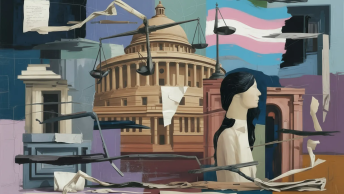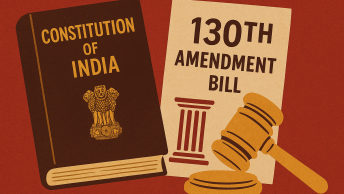This post is the first part of a three part series deconstructing the Sabrimala Verdict which opened the gates of temple to women devotees. You may find the second post here and the third post here.
A Constitution bench of the Supreme Court recently opened the gates of the Sabarimala temple to women devotees. Sabarimala is a popular pilgrimage temple for the Hindus which banned the entry of women aged 10-50 years. It was contented that the Temple Board had the right to regulate the entry of women in order to preserve the celibate characteristic of the Temple’s deity. With a majority of 4-1, the bench struck down this prohibitive practice with the sole woman judge on the bench, Justice Indu Malhotra in dissent. Now retired, Justice Dipak Misra delivered the majority verdict for Justice Khanwilkar and himself while Justice Chandrachud and Justice Nariman wrote separate concurring opinions.
The three-part series analyses the varied perspective of each judge on the critical issues which were under consideration in this case. This piece will deal with issues on (1) whether the devotees of Sabarimala formed a religious denomination under Article 26 and (2) the vires of Rule 3(b). The second part will deal with issues on (3) clash between Article 25(2) and Article 26; (4) court’s interpretation of the right to worship under Article 25; (5) interpretation of the word ‘Morality’ to which Articles 25 and 26 are subjected and (6) whether exclusion of women constituted an Essential Religious Practice? The last part of the series will deal with issues on (7) Rights of women under Article 14 and 21; (8) whether Article 17 can be expanded to include women and (9) the Legal Rights of the Deity under Article 21.
- Whether devotees of Sabarimala form a Religious Denomination under Article 26?
J Misra (para 94) and J Nariman (para 26) observed that that three conditions need to be met for an entity to constitute a religious denomination. It must consist of persons who have a common faith, common organisation and designated by a distinct name. J Chandrachud (para 63) observed that in addition to these three conditions, a fourth element has emerged from the narrative of judicial precedents, i.e. a common set of religious tenets. He explained “Religion is what binds a religious denomination. Caste, community and social status do not bring into being a religious denomination.” While J Malhotra did not explicitly mention the use of the three-condition test, she used the same (para 12.9) while cautioning that it was only for guidance and not a straitjacket formula (para 12.7). She also seems to give a higher importance to the condition of distinct practice/ beliefs and common belief (para 12.8).
As per the majority, the first condition was not fulfilled due to the following reasons. The devotees from all religions worship the temple without ceasing to be a part of that religion. Hence, they are regarded as “Hindus who worship Ayyappa as a part of the Hindu religious form of worship and not as denominational worshippers” (J Nariman, para 26), there existed no religious tenant peculiar to devotees of Ayyappa (J Misra, para 96). J Chandrachud observed that since the exclusion of women had not been consistently followed, the argument that exclusion of women due to a deity being celibate is a part their common religious belief was not established. (para 67). However, J Malhotra dissented and held that observance of a 41 day ‘Vratham’ and exclusion of women between 10-50 years were identifiable customs and usages, which are founded on the common faith of the deity being a ‘Naisthik Bhramachari’ and which showed that the first condition was fulfilled (para 12.9, ii).
Interestingly, one could observe from the abovementioned reasoning that J Nariman, in order to answer if the first condition is fulfilled, practically used the fourth as mentioned by J Chandrachud. This become clear when he observes “this Court had held that since persons of all religious faiths visit the Dargah as a place of pilgrimage, it may not be easy to hold that they constitute a religious denomination or a section thereof” (para 26). J Chandrachud similarly observed that since followers of all religious undertake the pilgrim, religion was not the basis of a collective of devotees and without a religious identity, one could not be said to be a religious denomination. (para 69). J Malhotra clearly rejected this kind of reasoning and drew attention to the fact that the practice of visiting shrines by people from other religious faith is not uncommon (para 12.12). She also observed that the Constitution ensures a secular society where there is place for diverse religions and denominations to co-exist, hence, ‘religious denomination’ should be interpreted in furtherance of the constitutional objective of a pluralistic society (para 12.13).
The second condition was not fulfilled as per J Misra, since there is no group that is identified as Ayyappans (as claimed by respondents), as every Hindu could visit the temple (para 94). J Chandrachud used a similar reasoning and observed that the temple is dedicated to the public and represents plural character of the society as everyone can, irrespective of religious belief, worship at the temple (para 69). J Nariman merely mentioned that there is no common organization of worshippers and further held that the third condition was not fulfilled since there is no distinctive name for worshippers (para 27).
J Malhotra while dissenting seemed to defend the fulfilment of second condition. She mentioned that the temple owned vast properties, which were taken over by the State subject to the obligation to pay annuities and that it was managed by the Travancore Devaswom Board (para 12.9, iii & iv). She was also convinced about fulfilment of the third condition due to the fact that there exist distinctive names for the followers. The male devotees are called ‘Ayyappans’, female devotees below 10 and above 50 as ‘Malikapurnams’, and together they are called Ayyappaswamis’ following the ‘Ayyappan Dharma’ (para 12.9, i)
- Whether Rule 3(b) violated the provisions of the parent act?
Section 3 of The Kerala Hindu Place of Public Worship (Authorisation of Entry) Act, 1965 (hereinafter referred to as “the Act”) provides that places of public worship which are open to Hindus shall be open to all sections and classes of Hindus. Further, Section 4 of the Act bestows the power to make regulation for the particular temple with the authority in charge of a public place, which, in this case, is the Sabarimala temple’s authority. A proviso to the section stipulates that no regulation made under it shall discriminate against any Hindu for belonging to a particular class or section. Rule 3(b) made by the state legislature under Section 4 laid down that women shall not be entitled to offer worship in any place of public worship at such time during which they are not allowed by custom and usage to enter the place.
All opinions except J. Malhotra’s struck Rule 3(b) down due to the reasons of it being ultra vires to the act and being unconstitutional in nature. J. Misra (para 127) and J. Chandrachud (para 83 to 85) observed Section 2(b) and 2(c), which denote the definitions of ‘Hindu’ and ‘section or class’ respectively to enquire who all are under the purview of this legislation. Using these, they established that the act is applicable to women as women form a ‘section or class’ under this act. J. Chandrachud also referred to the Long Title of the act (para 85) to conclude that the fundamental objective of this act was to bring social reform in the society and do away with all kinds of exclusionary measures practised in Hindu temples in Kerala. Thus, they concluded that the act was applicable to women and was intended for their benefit. Further, J. Chandrachud (para 83) and J. Misra (para 132) in their respective judgments, had concluded that Sabarimala and its devotees do not constitute a religious denomination. Thus, the temple will not get the benefit of the proviso to Section 3. This proviso allowed religious denominations or sections to manage their own affairs.
The concurring opinions further considered two major reasons for holding Rule 3(b), which justifies the prohibition on entry of women, as “illegal.”
First, the verdict included detailed discussion on delegated legislation. J. Misra (para 137) observed that when the rule making power is conferred under any statute on an authority, the said power has to be exercised within the ambit of the statute. J. Chandrachud (para 90) further remarked that Rule 3(b) was in direct contravention to the proviso of Section 4 as it discriminated against a class or section of Hindus. Additionally, all three concurring opinions noted that the impugned rule violated Section 3, a non-obstante clause, as well as defeated the intentions of the legislature as it discriminated against a suppressed class instead of emancipating it. Therefore, Rule 3(b) was stuck down for being ultra vires of the parent act.
Second, it was noted by J. Nariman that Freedom of Conscience and Right to enter the temple and worship their deity, secured under Article 25 of the Constitution, was being violated by the exclusion practised by the temple authority. Therefore, Rule 3(b), which statutorily supported this exclusion was held unconstitutional. Interestingly, while J. Nariman (para 29) largely based his analysis on Article 25(1) of the Constitution, J. Chandrachud as well as J. Mishra did not delve into the constitutional validity of Rule 3(b).
J. Malhotra based her opinion on her conclusion to consider the Sabarimala temple as a ‘religious denomination’ under Article 26 of the Constitution. In this light, she observed that the temple was covered by the exception to Section 3, and thus, Rule 3(b) was not ultra vires of the act.
Conclusion
The question of whether the devotees of Sabarimala constituted a religious denomination was very crucial to this case. The answer to this would determine whether the ban on entry was allowed as per the Section 3 of the Act. Though the majority ruled that the devotees do not constitute a religious denomination, such a narrow interpretation could substantially interfere with religious freedoms in the long run. J Malhotra’s dissent is of significant importance which recognises the need for a wider interpretation keeping in mind the pluralistic nature of Indian society.








Very good effort. Good reading.Wish you all the best.
Your point of view caught my eye and was very interesting. Thanks. I have a question for you.